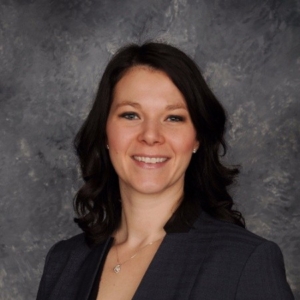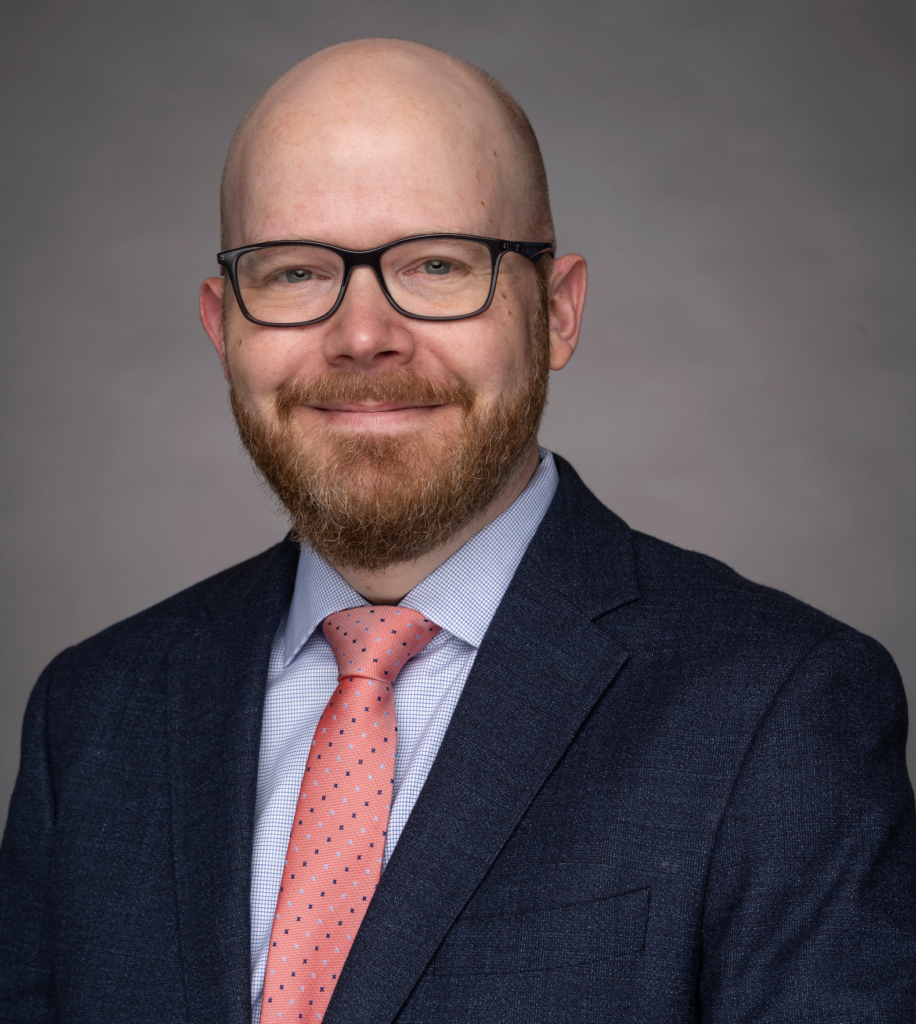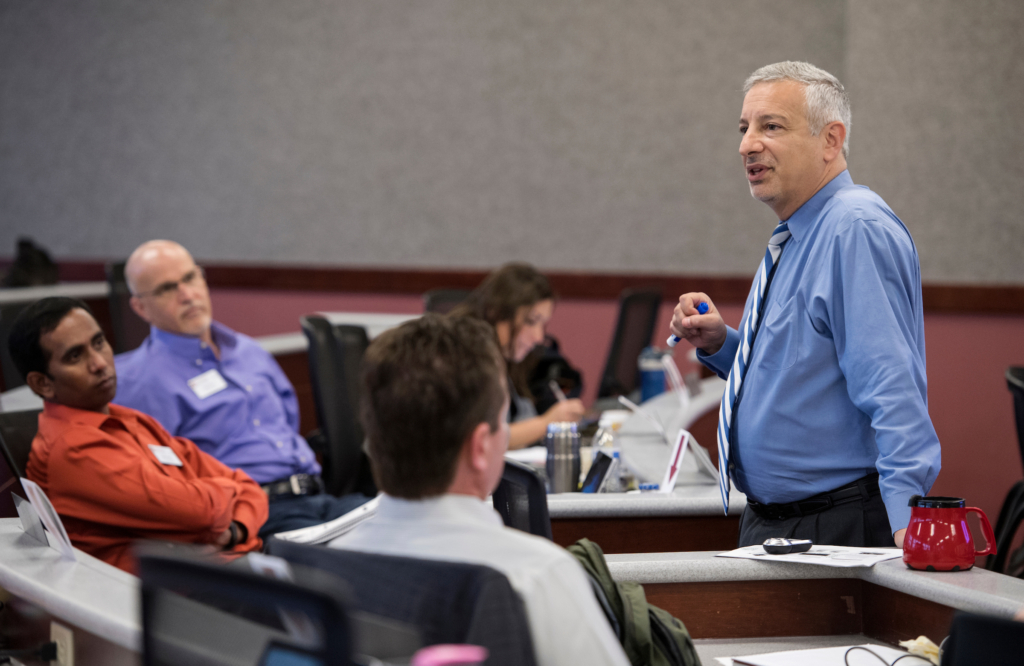
Grainger Hall, which is home to the Wisconsin School of Business, on the campus of the University of Wisconsin-Madison.
For most of her early career, Pamela Petz found herself in small business leadership roles. She took on projects, extra training, and any leadership responsibilities she could get her hands on.
She joined Great Wolf Lodge, an indoor water park in Baraboo, Wisconsin in 2019, starting as a corporate training manager. Though she was promoted to director of the company’s customer contact center fairly quickly, she knew a formal education would strengthen her business acumen and build her confidence.
“You don’t know what you don’t know, right?” says Petz, 42, a mother of two.
WISCONSIN EMBA SPOTLIGHT
When program shopping, Petz wanted a part-time program where she could keep working, but would provide in-person connections to build her network. She looked in her own backyard: the Wisconsin School of Business at University of Wisconsin-Madison, her alma mater, and the flagship campus of the UW system, often referred to as a Public Ivy.

Pamela Petz, EMBA ’18
With the competing priorities of home and work, she needed to report in-person with deadlines in order to hold herself accountable. So, she first considered the school’s Professional MBA.
“I remember having a call with Dale in the admissions office to determine if I would qualify. He asked me about the Executive program, but I didn’t think of myself as an executive at the time – that’s the C-suite!” says Petz. “After sharing my years of leadership experience and some professional accomplishments, he confirmed I could be considered. I was honored and excited at the opportunity to apply.”
What set the Wisconsin EMBA apart was its accessibility. Many of Petz’s professors came from industry, and they made themselves available after hours. The cohort approach and the Global Learning Experience added skill development such as leading strong teams, overcoming adversity, delegating, and more. And, the network of 39 professionals from her cohort became invaluable, she says.
Petz completed the program in 2018, and was promoted to assistant general manager and then to general manager.
“We had multiple industries and experience levels in the classroom from which we could pull countless examples pertaining to whatever topic we were reviewing,” she says. “It wasn’t something I gave much thought to when applying, but it ended up being the most valuable contribution to my learning. The school created a dynamic group of professionals that truly complemented each other.”
WISCONSIN’S NEWLY REDESIGNED HYBRID EMBA
The Wisconsin EMBA had no incoming cohort last fall after pausing admissions the previous year. The cohort numbers dropped to a low of 16 through the pandemic, and it didn’t want to have a program just for the sake of having a program, says Enno Siemsen, associate dean for MBA and Master’s programs at Wisconsin School of Business.
In that time, it has redesigned an Executive MBA that will enroll the first cohort in August 2024. The new hybrid program is shorter, taking just 18 months, and will require students to come to the Madison campus just once a month – compared to every other weekend in the previous version. Students will spend half their time in-person and half their time online.
|
Wisconsin School of Business Executive MBA At A Glance |
|
| Length | 18 months |
| Format | In-person classes one-weekend per month, Saturdays and Sundays; online classes for three hours on Wednesday evenings |
| Online/Hybrid Options | Content is delivered 50% in-person and 50% online |
| Cohort Size | Between 30 to 40 |
| Academics | Curriculum emphasizes leadership development, business strategy, and decision-making. It is organized into four modules: Develop as a leader, Run the Business, Grow the Business, and Transform the business. Also emphasizes experiential learning, executive mentoring, and career coaching. |
| Residencies | Two week-long residencies will focus on transformational leadership and executive communication. A global immersion trip is optional. |
| Entrance exams | GMAT/GRE not required but optional, EA is optional |
| Cost | $86,000 |
The new program also includes four new courses and optional badges for more upskilling after graduation. It emphasizes executive communication and its impact on expanding influence and reach while incorporating mentoring, coaching, and career development throughout. Learn more here.
This week, Poets&Quants For Execs is looking into Wisconsin School of Business’ redesigned program as part of our EMBA Spotlight series. Our conversation with Enno Siemsen, who has overseen the EMBA program since 2018, is presented below. It has been edited for length and clarity.
Let’s begin with a brief history of the Wisconsin EMBA.
The program started about 25 years ago. I think, initially, because this was something so unusual for the University of Wisconsin, it was sort of a Chancellor’s degree. It moved into a regular degree about 15 years ago or so.
It really has been a program very much focused on Madison, Milwaukee, and surrounding areas. It draws students from across Wisconsin, into Iowa, and northern Illinois. We pride ourselves in what we call the Wisconsin Idea, which is seeing ourselves as servants of the state and beyond. A lot of the business community participates in the program that students get to interact with.

Enno Siemsen, associate dean for MBA and Master’s programs
Many of our students continue interacting with the school afterwards, whether it’s with projects, through executive education, or coming back as speakers. So the program has always been more than just a program; It’s always a focal point to really connect to the business community.
What is the value proposition of the Wisconsin EMBA compared to its competitors?
First and foremost, the University of Wisconsin Madison is the flagship university in the state, and this is the Executive MBA Program of the flagship university in the state. It has always been a very solid academic program as well, and we’ve always paid particular attention to having really great instructors. The teaching evaluations in that program have always been the highest of my programs. It has a very strong faculty involvement, and it had all the bells and whistles you expect – from a global trip to coaching and career services and so on and so forth.
I think the competitive strength was that it was an EMBA offered by the flagship school with all the capabilities that a research university brings to the table. Students in the area wanted the prestige and the reputation that comes with that.
Tell us more about the new hybrid format. How does it work?
I was hired in 2018 to move into the dean’s office and really rejuvenate the portfolio for graduate programs. I did that first with our Professional MBA which was more the pressing issue. But I always knew that the Executive MBA was a fully in-person program, and students had to come to campus two times a month. The delivery format needed to be updated. So I knew that was something we had to work on, and the pandemic accelerated the pace.
We did quite a bit of market research, starting in 2020, to really understand what the audience wants. Our Professional MBA was sort of the replacement for our Evening MBA program – a part time program for people with a little bit less work experience. We introduced this hybrid format there already which is a one-weekend-a-month commitment. The rest is online.
So we knew that format worked incredibly well because that program resonated incredibly well in the market. I think it solves two underlying social phenomena that are a little bit in conflict: One, the pandemic taught all of us that information is at our fingertips, and people want a program that is perfectly accessible wherever they are, right there and then. But, they also want the human connection, to be in a room with others. They see the value of a cohort, and they want that network and the relationships that will help them for the rest of their careers.
I think most people don’t immediately realize it, but these two things are just diametrically opposed. To create a cohort with a lot of interaction, you need to put people in a room where they can actually interact with each other. That’s the opposite of having it all at your fingertips.
So, I think when you design a program like this, this hybrid format works; This one weekend a month is a magic formula. It really allows us to bring people regularly together to build a cohort, and then the rest essentially we do online.
Will students have the option to either do all of the EMBA online, or all of it in-person?
No, we don’t want to split our cohort into the people who are online and the people who are in the classroom because then they will not feel that connected to each other. We wanted one experience for everyone. And again, we’ve tested this out in the Professional MBA, and it works incredibly well.
Madison is already a weekend getaway for Chicagoans, it’s not a bad place to visit for a weekend except maybe in January. So people like to come to campus for one weekend a month and we want to capitalize on that.
Tell us more about the new curriculum.
We simplified the structure so every course is basically one month. It allows people to sort of focus on one topic at a time. That’s very important for executives; You have to let them focus. We’re going to experiment with a couple of courses that will sort of be taught in parallel, but in principle, it’s one course in one month.
We grouped the courses into four different buckets: The first is all around running the business, the second one is growing the business, and the third one is transforming the business. The fourth one is the leadership development which will continue throughout the program.
We also compressed the length. It used to be basically a two year program. Now it’s a year and a half. Students have to have significant work experience to get into the program, so there are some things that we can skip over.

Professor Russ Croff teaches a Business Strategy class with Executive MBA students before the program was paused due to the pandemic. (Paul L. Newby, II /UW-Madison Wisconsin School of Business)
You’ve also added a selection of badges executives can take after graduation.
When students sign up for the program, they get these 18 months of content, but they also get access to professional MBA badges after graduation that they can take it as non credit. So if they feel like there’s a topic that they want to go deeper into, they have that opportunity. For example, we have a badge on analytics. If they want to go and take the global trip, we have a badge for that. Badges are three month experiences and graduates have access to two of them for free.
We want to make it part of the post degree experience. The idea is this is a lifelong learning platform, so it’s a way of keeping them engaged for a longer time period.
Give us some examples on the badges and their content.
There’s a data analytics badge which contains material on databases, data technologies, data visualization and causal analysis that really gets you up to speed on the basics. I mean, very few of these executive students will really become data analysts, but they need to be sufficiently well trained so that they can manage a team of data analysts.
We have a responsibility badge we’re going to run for the first time this year. It has an ethics class, a sustainability class, and a class on diversity and inclusion. Again, very current topics, very important. These are all topics that we touch on in all of our courses to some degree, but if you really want to go deep, here’s a badge that allows you to go deep. We also have financial insights and customer insights badges.
I understand the program emphasizes effective communication and leadership. Tell us more about that.
We have two residences planned on these topics as part of the program that are not for credit, but students are expected to attend. We’ll do some activities that will link back to classroom exercises later in the program.
I think in our old program, we would have students who would say the classes were all great, but they’re still missing something in their personal development and leadership. You can get a little bit of that in class, but really a lot of that is happening outside the classroom. It comes from the coaching, from in-depth one-on-one training, from reflection, and from the ability to figure out where your deficiencies and strengths are.
And, of course, all leaders have to communicate to different audiences in different ways. You have to be able to communicate to your own employees, you have to be able to communicate to customers. You have to be able to communicate to your boards, and you have to communicate to investors.
So, we brought in several people from our Dean’s Advisory Board who do executive and communications coaching to work with our communications group within the School of Business. They developed, I think, a very exciting, very experiential, extracurricular course to take place over the two residencies and that will continue throughout the program. It also adds to the executive coaching element on becoming a better person and leader. I’m very proud of what my team has created.
What is the target cohort size for the hybrid EMBA? Is there room to add extra cohorts, do you think?
The very first year I took over the EMBA, we had an unusually large cohort of about 55 students. By the time we hit the pause button on the program during the pandemic, it was down to 15. So we are aiming for something in between.
I would be very happy with a cohort of 30 to 40 students. One thing we noticed with the Professional MBA is that our geographic reach vastly extended from what used to be a very local program. Almost everybody in the country can fly in for one weekend a month.
A lot of alumni may think the executive EMBA is now within their reach. So if a geographic reach expands for the Executive MBA as it did for the Professional MBA, that means the market size itself increases, and we can start thinking about going to multiple cohorts. But that’s a problem for a different time.

Wisconsin School of Business’s new EMBA is shorter, has a hybrid format, and has new courses and badges. The redesigned program will enroll its first cohort in August 2024. Courtesy photo
What about the new curriculum has you most excited?
We have a few new courses that I’m excited to see how they go. For example, we have a new course on corporate governance and board membership. This is sort of one of those topics where it sounds incredibly boring, but there’s just so much more that is happening right now in the governance space that is very exciting.
We also have a new class, Competing Through AI. AI, which you know, is a very fast developing space and is enabling very new and different business models. It’s going to probably be a course which has to be rewritten every single year.
We also added a course on marketing growth strategies. Instead of just another marketing class, we really wanted something focused on growth and strategic growth. There’s a lot of academic content that I’m very excited about that we will pilot in the Executive MBA because we’ll get good and immediate feedback.
But really, the communications training is what I’m most excited about. When we designed this program, one of the immediate questions was how is it different from our Professional MBA because the format is the same. The difference comes in the content. In the EMBA, you get people at a different stage in their careers. They are on the path to the C suite or they want to become senior leaders. What they want in terms of content is leadership, strategy and decision making, etc.
What kind of student are you targeting?
We’re looking for people with 15 years of work experience, maybe nine or 10 years for a particularly strong candidate. We’re looking for people who are leaders already or rising leaders in their organizations. We’re looking for the next leaders in Wisconsin, whether it’s in for-profit organizations, nonprofit organizations, medical doctors, or health system administrators.
Anything else you’d like to add?
We do want to have a project that will be the central part of their experience. Either projects that the students bring themselves from their organizations or on real nonprofit projects in the community. A lot of times, nonprofits have come to us for help on a new strategy or project. This is a great audience to bring in four or five executive MBAs, let them work with a nonprofit for 8 to 10 months, and help them get to the next stage.
I think there’s so much value in that, again going back to the Wisconsin Idea. That’s what we’re trying to accomplish. We love to facilitate these kinds of projects, so I’m very excited to see that they are now a key element of the whole program.
DON’T MISS THESE STORIES IN OUR EMBA SPOTLIGHT SERIES:





Questions about this article? Email us or leave a comment below.